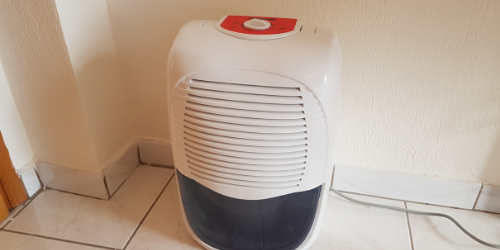How to use a dehumidifier in the basement?
3 Key Takeaways:
🚀 Excess moisture in the air can cause a range of problems, including health issues, mold growth, and structural damage.
🚀 Choosing the right size and type of dehumidifier for your basement is important. Consider factors such as the humidity level, square footage, ventilation, and temperature.
🚀 It’s important to consult with a professional to analyze your basement’s specific needs and requirements before deciding on the right dehumidifier for your space.
Our expert tips on using dehumidifier correctly.
Excess moisture content in the air is a hazard. No matter which part of your living space is battling excess moisture content in the air, the problems it brings with it are going to persist if you do not find a way to remove excess moisture at the earliest.
Health problems from asthma and allergies, respiratory illness, dust mites, mold spores accompanied with mold growth, mildew, wood rot, cracked ceilings, separated wood floors, damp walls, structural damage, etc., are some of the many issues that arise with humidity problems.
One must find ways to maintain the relative humidity levels in the environment to keep these issues at bay. More moisture will lead to more trouble, which will result in you shelling out more money than necessary.
Laundry rooms, crawl spaces, and basements are one of the most neglected parts of a home. These isolated dark and moisture-filled places become the house to mold growth quite often. Using basement dehumidifiers to remove moisture from the air and keep the indoor humidity balanced is the best solution to this problem. The functions between high and low temperatures in these spaces, often lead to homeowners running a basement dehumidifier year-round.
Let us learn how to use a dehumidifier and how a dehumidifier works in a basement and what to remember while using it.
What kind of dehumidifier do you need for basement?

Getting the right size dehumidifier is an important step that you cannot overlook. Solving the humidity problem in the basement largely depends on what kind of basement dehumidifier you are getting.
There are different models available in the market, each of them sporting a different feature. Some things to remember when you run a dehumidifier in a basement is that,
What is the basement humidity approximately on a regular basis?
You might not be visiting the area quite often so you must have proper drainage in store?
What are the square feet of the space expected to cover?
Does the basement have room for an exhaust fan, the ventilation of the area?
Is the basement at the risk of running into lower temperatures?
Is there pre-existing structural damage?
Is your home equipped with an HVAC system that can cover the basement and crawl space as well?
Would you benefit from portable dehumidifiers or you want exclusive basement dehumidifiers?
These are a few of the many questions you need to ask yourself and analyze the situation and requirements of your basement with a certified professional. On making a thorough study of the space, the professional will be able to help you decide which would be the right dehumidifier for your basement.
How big of a dehumidifier do you need for my basement?
Getting the right size dehumidifier for any area is crucial. How well a dehumidifier works to remove excess moisture from the air and maintain the basement humidity level is entirely dependent on its capacity. Hence it is important to pay attention to this detail. Here is the most followed estimation when it comes to buying basement dehumidifiers.
In order to dehumidify a basement with an area of 1000 square feet, it is recommended to get a 14-pint capacity dehumidifier. If the area has a high humidity level at all times and is filled with dampness, you can choose a basement dehumidifier that can hold 12 pints of water for a 500 square feet area. To this, add an additional 5 pints for every 500 square feet.
When should you use a dehumidifier in the basement?

The need for a basement dehumidifier arises when the relative humidity level has to be maintained. To get rid of excess humidity in the basement, it is advised to run a dehumidifier in the basement as and when required.
If you notice that the relative humidity levels are above 50 percent and are consistently high, it is important to use a dehumidifier to remove moisture that is accumulated in the basement (or other rooms as well) and balance out the indoor humidity.
Sometimes, there can be obvious signs of damage caused by excess humidity levels in the space. Mold growth, persistent health problems, wood rot and structural damage, poor indoor air quality, are some of the signs that point out that your basement is affected by high humidity and is in need of a dehumidifier.
Where should you put a dehumidifier in the basement?
You cannot underestimate the difference placing the dehumidifier at the right spot would make. Effective dehumidification does not stop with purchasing the right dehumidifier. You have to set it in the correct place to make the best use of the basement dehumidifier work potential.
If the humidity problem in your basement is minimal and you own a portable dehumidifier, it is best advised to place the device on the floor. It has been proved that dehumidifiers work to the best of their efficiency when they are in close proximity to the source of moisture. Being close to the ground is certainly going to have a huge impact on how they remove excess moisture from the area.
Keeping the dehumidifier on an elevated surface reduces the convection circulation of air. When the unit is placed on the floor, it was seen that the dehumidifier released warmer air than what it took in. We know that the unit will draw air that is laden with moisture, run it over its frozen coils, extract the moisture from the air and send back drier air into the room.
The moisture collected via condensation is turned into water and collected in the tank below. This collected water can be emptied out using a drain hose or condensate pump, or sump pump (depending on the dehumidifier model).
For this air absorption to take place effectively, the unit must be placed in a position that does not hinder the device to draw air into it. Keeping the dehumidifier at a convenient distance from the wall, removing all furniture or other objects that are near the air filter, and block the movement of air must be removed. Placing the dehumidifier close to the sump pump or outlet for proper drainage is another aspect to consider to avoid spills.
What temperature should a basement dehumidifier be set at?

Most dehumidifiers have settings that permit you to set the temperature and relative humidity that you prefer the unit to be operating upon. Setting the dehumidifier to a basement humidity of 60% or below might be comfortable. However, it is widely agreed upon that 45% to 50% is comfortable and good settings to maintain the room at.
How much does it cost to install a basement dehumidifier?
The cost of installing basement dehumidifiers will vary depending on different factors. The type of dehumidifier, the number of dehumidifiers to be installed, etc. Moreover, your local area might have certain fixed rates within which the companies or professionals might operate. Here is an average range of costs for installing a basement dehumidifier.
A whole-house dehumidifier installation can cost anywhere from $1,500 to $2,800. Likewise installing a dehumidifier in your crawl space can cost from $1,500 to $2,000. Installing basement dehumidifiers can cost you from $1,300 to $1,800.
These rates might vary between professionals.
How do you lower the humidity in an unfinished basement?

High humidity levels can be lowered in an unfinished basement by following some simple tips.
1. Open out some windows
Promoting air circulation in the space will help to reduce high humidity. Opening up the windows is a great way to ensure there is some air circulation happening within the area. If your basement has windows or vents in it, open them out whenever possible. This will help to bring down high humidity.
2. Increase the temperature
Did you know that maintaining the relative humidity level in the air can be done by just heating up space? This increases the temperature in the room by just a tad bit and can help to reduce the existing humidity levels. Low temperatures become the ideal place for dampness and moisture accumulation. Next time you notice humidity building up and want some quick relief in your basement when you cannot or do not use a dehumidifier at that moment, just turn up the thermostat by a little bit.
3. Remember to keep the area clean and free from clutter
Darkness. Mold and mildew thrive in dark and damp areas. Having too many things around the house or basement that are difficult to clean will become the breeding grounds for mold and mildew or even other allergens.
Mold growth can be prevented by keeping the space clutter-free and clean. Humidity can be kept under control by keeping the basement and other rooms of the house free from clutter.
4. Seal the gaps
Humid air escaping into the house is a silent source of high humidity. Identify the small gaps, holes, or cracks through which humid air from the outside can slip easily into the basement and other rooms in the home.
5. Invest in a dehumidifier
The right basement dehumidifier works for your benefit. The powerful water extraction that a basement dehumidifier can give you is going to balance the humidity levels in your place like nothing else.
Basement dehumidifiers come with a wide range of advanced features that will make maintaining relative humidity simple. The recent updates to models include Energy Star certification (in line with Environmental Protection Agency), Automatic Shut Down and Shut Off, Automatic Defrost, Auto Restart, etc. You can also make the pick between different types and models; be it portable dehumidifiers or units installed into your HVAC system.
FAQ Section
1. Do most basements need a dehumidifier?
Yes. Basements are areas that are naturally damp and filled with moisture, which leads to high humidity. The rise in humidity levels is the main reason for fungal activities and drop-in indoor air quality. Preventing mold growth, mildew, structural damage, and one of the best resorts to improve indoor air quality (with an air filter) in your basement is by investing in a good and suitable basement dehumidifier.
When you run a dehumidifier in crawl spaces or basements (or even other rooms), you can be assured that these devices will monitor the fluctuating humidity levels. The unit will draw air that is moisture-filled from your basement’s environment and property. It will absorb the excess water and send back drier air. Since most basements struggle at maintaining humidity levels, dehumidifiers are the ideal choice to achieve the need.
2. Will a dehumidifier dry out my basement?
Yes! You can study thorough research on how dehumidifiers work and their impact on the existing humidity levels in a space before you purchase a unit. Your basement dehumidifier is equipped to not just dry out the basement and get rid of the dampness, rather it comes with several benefits. You can remove mold growth, ensure that mold spores are dormant, improve indoor air quality with the help of the air filters within the unit, prevent structural damage, etc., when you use a dehumidifier.
3. How long should you run a dehumidifier in the basement?
Experts recommend that crawl spaces and basements could benefit a large extent when you run a dehumidifier for 12 hours. This time length can assure you to keep the humidity levels under control.
Wrapping Up
Hope you found the article helpful in understanding how to use a dehumidifier in the basement. Share with us your experience in using basement dehumidifiers and how they have worked for you in maintaining humidity levels in your basement area.

About The Author
Olivia — a self-confessed air quality addict — is a home climate enthusiast, fresh air advocate, and someone with deep personal experience and knowledge about mold extermination. Her work was mentioned in countless notable humidity publications. Previously she was an editor at Mold Remediation.